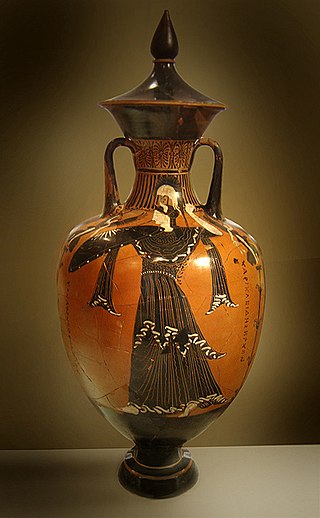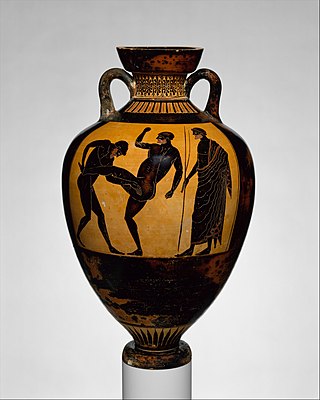
An amphora is a type of container with a pointed bottom and characteristic shape and size which fit tightly against each other in storage rooms and packages, tied together with rope and delivered by land or sea. The size and shape have been determined from at least as early as the Neolithic Period. Amphorae were used in vast numbers for the transport and storage of various products, both liquid and dry, but mostly for wine. They are most often ceramic, but examples in metals and other materials have been found. Versions of the amphorae were one of many shapes used in Ancient Greek vase painting.

Pottery, due to its relative durability, comprises a large part of the archaeological record of ancient Greece, and since there is so much of it, it has exerted a disproportionately large influence on our understanding of Greek society. The shards of pots discarded or buried in the 1st millennium BC are still the best guide available to understand the customary life and mind of the ancient Greeks. There were several vessels produced locally for everyday and kitchen use, yet finer pottery from regions such as Attica was imported by other civilizations throughout the Mediterranean, such as the Etruscans in Italy. There were a multitude of specific regional varieties, such as the South Italian ancient Greek pottery.

Black-figure pottery painting, also known as the black-figure style or black-figure ceramic, is one of the styles of painting on antique Greek vases. It was especially common between the 7th and 5th centuries BCE, although there are specimens dating as late as the 2nd century BCE. Stylistically it can be distinguished from the preceding orientalizing period and the subsequent red-figure pottery style.

Exekias was an ancient Greek vase painter and potter who was active in Athens between roughly 545 BC and 530 BC. Exekias worked mainly in the black-figure technique, which involved the painting of scenes using a clay slip that fired to black, with details created through incision. Exekias is regarded by art historians as an artistic visionary whose masterful use of incision and psychologically sensitive compositions mark him as one of the greatest of all Attic vase painters. The Andokides painter and the Lysippides Painter are thought to have been students of Exekias.

The Kleophrades Painter is the name given to the anonymous red-figure Athenian vase painter, who was active from approximately 510–470 BC and whose work, considered amongst the finest of the red-figure style, is identified by its stylistic traits.

The Berlin Painter is the conventional name given to an Attic Greek vase-painter who is widely regarded as a rival to the Kleophrades Painter, among the most talented vase painters of the early 5th century BCE.

Panathenaic amphorae were the amphorae, large ceramic vessels, that contained the olive oil given as prizes in the Panathenaic Games. Some were ten imperial gallons and 60–70 cm (24–28 in) high. This oil came from the sacred grove of Athena at Akademia. The amphorae which held it had the distinctive form of tight handles, narrow neck and feet, and they were decorated with consistent symbols, in a standard form using the black figure technique, and continued to be so, long after the black figure style had fallen out of fashion. Some Panathenaic amphorae depicted Athena Promachos, goddess of war, advancing between columns brandishing a spear and wearing the aegis, and next to her the inscription τῶν Ἀθήνηθεν ἄθλων "(one) of the prizes from Athens". On the back of the vase was a representation of the event for which it was an award. Sometimes roosters are depicted perched on top of the columns. The significance of the roosters remains a mystery. Later amphorae also had that year's archon's name written on it making finds of those vases archaeologically important.

The pottery of ancient Greece has a long history and the form of Greek vase shapes has had a continuous evolution from Minoan pottery down to the Hellenistic period. As Gisela Richter puts it, the forms of these vases find their "happiest expression" in the 5th and 6th centuries BC, yet it has been possible to date vases thanks to the variation in a form’s shape over time, a fact particularly useful when dating unpainted or plain black-gloss ware.

The Providence Painter is the conventional name given to a painter of the Attic red-figure style. He was active around 470 BC.

The Pan Painter was an ancient Greek vase-painter of the Attic red-figure style, probably active c. 480 to 450 BC. John Beazley attributed over 150 vases to his hand in 1912:
Cunning composition; rapid motion; quick deft draughtsmanship; strong and peculiar stylisation; a deliberate archaism, retaining old forms, but refining, refreshing, and galvanizing them; nothing noble or majestic, but grace, humour, vivacity, originality, and dramatic force: these are the qualities which mark the Boston krater, and which characterize the anonymous artist who, for the sake of convenience, may be called the 'master of the Boston Pan-vase', or, more briefly, 'the Pan-master'.

The Archaeological Museum of Eretria is a museum in Eretria, in the Euboea regional unit of Central Greece.

The Horsehead Amphora is a specific type of amphora, produced in Athens from about 600 BC onwards. They are vessels with a very pronounced belly, decorated with black figure horseheads on both sides. In a single case, one side depicts a woman's head. In contrast to earlier belly amphorae, the painters did not apply a separate frieze on the neck. The decoration was painted within reserved rectangular panels; the remaining vase of the body was painted black. More than 100 such amphorae are known; they were painted by a variety of artists, including ones of mediocre quality.

Burgon Group is the conventional name given to a group of Attic black-figure vase painters active in the middle third of the sixth century BC.

The Euphiletos Painter was an Attic black-figure vase painter active in the second half of the sixth century BC.

Bilingual vase painting is a special form of ancient Greek vase painting. The term, derived from linguistics, is essentially a metaphorical one; it describes vases that are painted both in the black-figure and in the red-figure techniques. It also describes the transitional period when black-figure was being gradually replaced in dominance by red-figure, basically the last quarter of the 6th and the very beginning of the 5th century BC. Their appearance may be due to the initial uncertainty of the market for the new red-figure style, although that style subsequently became dominant rather fast.

The Lysippides Painter was an Attic vase painter in the black-figure style. He was active around 530 to 510 BC. His conventional name comes from a kalos inscription on a vase in the British Museum attributed to him; his real name is not known.

The Mastos Painter was a painter of ancient Greek vases. He is named for a black-figure mastos used by the art historian John Boardman to illustrate the type, which is shaped like a woman's breast.

The Judgement of Paris Amphora is an Attic black-figure amphora named for the scene depicted on it. It is held by the Musée des beaux-arts de Lyon with the inventory number E 581-c and is attributed to the London B76 Painter, who was active at Athens in the second quarter of the sixth century BC.

Athletics were an important part of the cultural life of Ancient Greeks. Depictions of boxing and bull-leaping can be found back to the Bronze Age. Buildings were created for the sole use of athletics including stadia, palaestrae, and gymnasiums. Starting in the Archaic period, Panhellenic Games, including the Olympic Games, begin taking place each year. These games gave people from all over Greece the chance to gain fame for their athletic prowess. Athletics in Greece became one of the most commonly depicted scenes of everyday life in their art.

The Kleophrades Panathenaic prize amphora is an Archaic period amphora by the Kleophrades Painter from the collection of the Metropolitan Museum of Art. Dating to c. 500 BCE, the amphora, filled with olive oil, was the prize for a victor in the Panathenaia games in Athens. This particular amphora is a neck amphora that stands at 63.5 centimetres (25.0 in) tall.



















